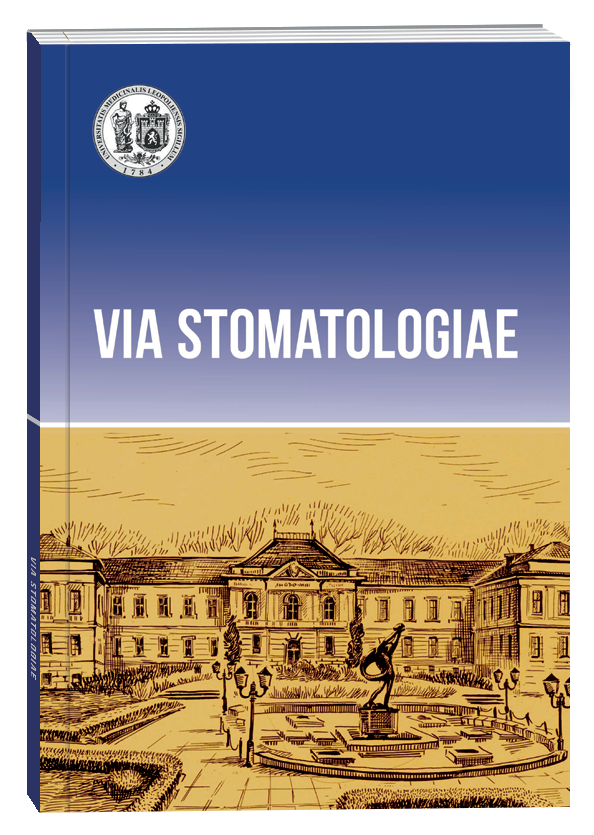THE ROLE OF APOPTOSIS AND IMMUNE RESPONSE IN THE PATHOGENESIS OF PERIODONTAL TISSUE DISEASES (REVIEW OF PROBLEMATIC ISSUES)
DOI:
https://doi.org/10.32782/3041-1394.2024-1.3Keywords:
chronic generalized periodontitis, pathogenesis, cell, apoptosis, immune system, literature reviewAbstract
The aim is to analyze the results of researches of recent years and to formulate on its basis a tentative idea of some aspects of apoptotic and immune processes as separate links in the complex and multifaceted pathogenesis of chronic generalized periodontitis. Materials and methods of the study. The methodology of this study was based on the search and analysis of scientific results on the outlined problematic issues of apoptotic and immune processes in the pathogenesis of chronic generalized periodontitis, published in publications presented in the evidence databases MEDLINE/PubMed, PMC, Scopus, Web of Science, Cochrane, Google Scholar, ResearchGate and other scientific and practical resources. Scientific novelty. The scientific data on the influence of complex apoptotic mechanisms that control cell loss and immune system function on the development and progression of chronic generalized periodontitis were analyzed. Conclusions. 1. It has been established that apoptosis or programmed cell loss may be one of the important mechanisms underlying the pathophysiology of periodontal tissue disease progression. 2. During the course of the pathological process, the presence of pathogen-associated molecular structures induces specific antimicrobial immune responses to control the infection. Under certain circumstances, cells can regulate their death (apoptosis) to accommodate the immune response, thus altering the impact that their loss will have on the environment. The final steps in the signaling pathway leading to apoptosis involve the activation of several proteases, including caspases and endonucleases. During cell apoptosis, caspase activation may be functionally involved in the tissue damage associated with chronic generalized periodontitis. 3. The dominance of Th1 cells (T-helper 1) leads to an aggressive course of the pathological process, significant bone resorption and decreased osteogenesis due to increased production of interleukins - IL-1 and IL-2. At the same time, the Th2 phase, accompanied by increased secretion of B cells - interleukin stimulators, has a protective function. 4. During inflammation of periodontal tissues, the activation of certain subtypes of T and B cells, as well as their production of cytokines, are decisive in determining whether the pathological process will develop as reversible gingivitis or progress as generalized periodontitis with the formation of deep periodontal pockets and vertical bone defects.
References
Kassebaum N.J., Bernabé E., Dahiya M., Bhandari B., Murray C.J., Marcenes W. (2014). Global burden of severe periodontitis in 1990-2010: a systematic review and meta-regression. J Dent Res, 93 (11), 1045–53. doi: 10.1177/0022034514552491.
Cagnetta V., Patella V. (2012). The role of the immune system in the physiopathology of osteoporosis. Clin Cases Miner Bone Metab, 9(2), 85 фосфатидилсерін трансфераза 8.
Listyarifah D., Al‐Samadi A., Salem A., Syaify A., Salo T., Tervahartiala T., Ainola M. (2017). Infection and apoptosis associated with inflammation in periodontitis: An immunohistologic study. Oral Diseases, 23(8), 1144–1154.
Tamura T., Zhai R., Takemura T., Ouhara K., Taniguchi Y., Hamamoto Y., Fujimori R., Kajiya M., Matsuda S., Munenaga S., Fujita T., Mizuno N. (2022). Anti-Inflammatory Effects of Geniposidic Acid on Porphyromonas gingivalis-Induced Periodontitis in Mice. Biomedicines, 10(12), 3096. DOI: 10.3390/biomedicines10123096.
Köseoğlu S., Sağlam M., Pekbağrıyanık T., Savran L., Sütçü R. (2015). Level of Interleukin-35 in Gingival Crevicular Fluid, Saliva, and Plasma in Periodontal Disease and Health. J Periodontol, 86(8), 964–71. DOI: 10.1902/jop.2015.140666.
Christgen S., Tweedell R.E., Kanneganti T.D. (2022). Programming inflammatory cell death for therapy. Pharmacol Ther, 232, 108010. DOI: 10.1016/j.pharmthera.2021.108010.
Tsukasaki M. (2021). RANKL and osteoimmunology in periodontitis. J Bone Miner Metab, 39(1), 82–90. DOI: 10.1007/s00774-020-01165-3.
Ravichandran K.S. (2010). Find-me and eat-me signals in apoptotic cell clearance: progress and conundrums. J Exp Med, 207(9), 1807–17. DOI: 10.1084/jem.20101157.
Tang D., Kang R., Berghe T.V., Vandenabeele P, Kroemer G. (2019). The molecular machinery of regulated cell death. Cell research, 29(5), 347–364.
Aral K., Aral C.A., Kapila Y. (2019). The role of caspase-8, caspase-9, and apoptosis inducing factor in periodontal disease. J Periodontol, 90(3), 288–294. DOI: 10.1002/JPER.17-0716.
Jiang W., Deng Z., Dai X., Zhao W. (2021). PANoptosis: A New Insight Into Oral Infectious Diseases. Front Immunol, 12, 789610. DOI: 10.3389/fimmu.2021.789610.
Wang L., Zhu Y., Zhang L., Guo L., Wang X., Pan Z., Jiang X., Wu F., He G. (2023). Mechanisms of PANoptosis and relevant small-molecule compounds for fighting diseases. Cell Death Dis, 14(12), 851. DOI: 10.1038/s41419-023-06370-2.
Song B., Zhou T., Yang W.L., Liu J., Shao L.Q. (2017). Programmed cell death in periodontitis: recent advances and future perspectives. Oral Dis, 23(5), 609–619. DOI: 10.1111/odi.12574.
Messmer U.K., Pfeilschifter J. (2000). New insights into the mechanism for clearance of apoptotic cells. Bioessays, 22(10), 878–81. DOI: 10.1002/1521-1878(200010)22:10<878::AIDBIES2>3.0.CO;2-J.
Kaiser W.J., Sridharan H., Huang C., Mandal P., Upton J.W., Gough P.J., Sehon C.A., Marquis R.W., Bertin J., Mocarski E.S. (2013). Toll-like receptor 3-mediated necrosis via TRIF, RIP3, and MLKL. J Biol Chem, 288(43), 31268–79. DOI: 10.1074/jbc.M113.462341.
Abuhussein H., Bashutski J.D., Dabiri D., Halubai S., Layher M., Klausner C., Makhoul H., Kapila Y. (2014). The role of factors associated with apoptosis in assessing periodontal disease status. J Periodontol, 85(8), 1086–95. DOI: 10.1902/jop.2013.130095.
Lim J., Park H., Heisler J., Maculins T., Roose-Girma M., Xu M., Mckenzie B., van Lookeren Campagne M., Newton K., Murthy A. (2019). Autophagy regulates inflammatory programmed cell death via turnover of RHIM-domain proteins. Elife, 8, e44452. DOI: 10.7554/eLife.44452.
Figueredo C.M., Lira-Junior R., Love R.M. (2019). T and B Cells in Periodontal Disease: New Functions in A Complex Scenario. Int J Mol Sci, 20(16), 3949. DOI: 10.3390/ijms20163949.
Rath-Deschner B., Nogueira A.V.B., Memmert S., Nokhbehsaim M., Augusto Cirelli J., Eick S., Miosge N., Kirschneck C., Kesting M., Deschner J., Jäger A., Damanaki A. (2021). Regulation of Anti-Apoptotic SOD2 and BIRC3 in Periodontal Cells and Tissues. Int J Mol Sci, 22(2), 591. DOI: 10.3390/ijms22020591.
Aral K., Aral C.A., Kapila Y. (2019). The role of caspase-8, caspase-9, and apoptosis inducing factor in periodontal disease. J Periodontol, 90(3), 288–294. DOI: 10.1002/JPER.17-0716.
Das P., Chopra M., Sun Y., Kerns D.G., Vastardis S., Sharma A.C. (2009). Age-dependent differential expression of apoptosis markers in the gingival tissue. Arch Oral Biol, 54(4), 329–36. DOI: 10.1016/j.archoralbio.2009.01.008.
Kawase T., Okuda K., Yoshie H. (2007). Extracellular ATP and ATPgammaS suppress the proliferation of human periodontal ligament cells by different mechanisms J Periodontol, 78, 748–756.
Kurita-Ochiai T., Seto S., Suzuki N., Yamamoto M., Otsuka K., Abe K., Ochiai K. (2008). Butyric acid induces apoptosis in inflamed fibroblasts. J Dent Res, 87(1), 51–55. DOI: 10.1177/154405910808700108.
Cekici A., Kantarci A., Hasturk H., Van Dyke T.E. (2014). Inflammatory and immune pathways in the pathogenesis of periodontal disease. Periodontol 2000, 64(1), 57–80. DOI: 10.1111/prd.12002.
Campbell L., Millhouse E., Malcolm J., Culshaw S. (2016). T cells, teeth and tissue destruction - what do T cells do in periodontal disease? Mol Oral Microbiol, 31(6), 445–456. DOI: 10.1111/omi.12144.
Cheng W.C., Saleh F., Abuaisha Karim B., Hughes F.J., Taams L.S. (2018). Comparative analysis of immune cell subsets in peripheral blood from patients with periodontal disease and healthy controls. Clin Exp Immunol, 194(3), 380–390. DOI: 10.1111/cei.13205.
Dutzan N., Konkel J.E., Greenwell-Wild T., Moutsopoulos N.M. (2016). Characterization of the human immune cell network at the gingival barrier. Mucosal Immunol, 9(5), 1163–1172. DOI: 10.1038/mi.2015.136.
Zouali M. (2017). The emerging roles of B cells as partners and targets in periodontitis. Autoimmunity, 50(1), 61–70. DOI: 10.1080/08916934.2016.1261841.
Liu S., Liu G., Luan Q., Ma Y., Yu X. (2022). Porphyromonas gingivalis Lipopolysaccharide-Induced B Cell Differentiation by Toll-like Receptors 2 and 4. Protein Pept Lett, 29(1), 46–56. DOI: 10.2174/0929866528666211118085828.
Oliver-Bell J., Butcher J.P., Malcolm J., MacLeod M.K., Adrados Planell A., Campbell L., Nibbs R.J., Garside P., McInnes I.B., Culshaw S. (2015). Periodontitis in the absence of B cells and specific anti-bacterial antibody. Mol Oral Microbiol, 30(2), 160–169. DOI: 10.1111/omi.12082.







